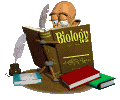| Chapter
Objectives
- Describe the hypothesis,
experiments, and conclusions about mechanisms of phototropism
proposed by
- Charles Darwin
- Francis Darwin
- Peter Boysen Jensen
- F. W. Watt
- List 5 classes of plant
hormones, describe their major functions, and recall where
they are produced in the plant
- Explain how a hormone
may cause its effect on plant growth and development
- Describe a possible
mechanism for polar transport of auxin
- According to the acid-growth
hypothesis, explain how auxin can initiate cell elongation
- Explain wy 2,4-D is
widely used as a weed killer
- Explain how the ratio
of cytokinin to auxin affects cell division and cell differentiation
- Define apical dominance
and describe th check-and-balance control fo lateral branching
by suxins and cytokinins
- List several factors
besides auxin from the terminal bud that may control apical
dominance
- Describe how stem elongation
and fruit growth depend on a synrgism between auxin and gibberillins
- Explain how the probable
mechanism by which gibberellins trigger seed germination
- Describe how abscisic
acid (ABA) helps prepare a plant for winter
- Explain the antagonistic
relationship between ABA and gibberillins and how it is possible
for growing buds to have a higher concentration of ABA than
dormant buds
- Give an example of how
ABA can act as a stress hormone
- Describe the role of
ethylene in plant senescence, fruit ripening, and leaf abscission
- Discuss how the study
of mutant varieities of plants has heightened our understanding
of plant hormones
- Describe the components
of a signal-transduction pathway
- List 2 environmental
stimuli for leaf abscission
- Define tropism and lit
3 stimuli that induce tropisms and a consequent change of
body shape
- Explain how light causes
a phototropic response
- Describe how plants
apparently tell up from down and explain why roots display
positive gravitropism and shoots exhibit negative gravitropism
- Distingush between thigmotropism
and thigmomorphogenesis
- Describe how motor orans
within pulvni can cause rpaid leaf movement and sleep movements
- Provide a plausible
explanation for how a stimulus that causes rapid leaf movement
can be transmitted through the plant
- Define circadian rhythm
and explain what happens when an organism is artiicially maintained
in a constant environment
- List some common factors
that entrain biological clocks
- Define photoperiodism
- Distinguish among short-day
plants, long-day plants, and day-neutral plants; give common
examples of each and explain how they depend on critical night
length
- Provide evidene for
the existence of a florigen
- Explain how the interconversion
of phytochrome can act as a switching mechanism to help plants
detect sunlight and trigger many plant responses to light
- Using photoperiodism
as an example, explain how an integrated control system can
regulate a plant process such as flowering
- Explain the molecular
basis of resistance to nonvirulent pathogens
- Describe the local and
systemic response to virulent pathogens
|
| Chapter
Terms:
hormone
phototropism
auxin
cytokinins
gibberellin
abscisic acid (ABA)
ethylen
senescence
oligosaccharins
brassinosteroids
|
tropisms
gravitropism
statoliths
thigmomorphogenesis
action potentials
sleep movements
circadian rhythm
photoperiodism
short-day plant
long-day plant
|
day-neutral plant
phytochrome
heat-shock protens
gene-for-gene recognition
phytoalexins
PR proteins
hypersensitive response
systemic acquired
resistance (SAC)
|
|
| Chapter
Outline Framework
- Plant Hormones
- Research on how
plants grow toward light led to the discovery of plant
hormones
- Plant hormones help
coordinate growth, development, and responses to environmental
stimuli
- Analysis of mutant
plants is enhancing plant research
- Signal-transduction
pathways link cellular responses to hormone signals and
environmental stimuli
- Plant Movements as Models
for Studying Control Systmes
- Tropisms orient
the growth of plant organs
- Turgor movements
are relatively rapid, reversible plant responses
- Control of Daily and
Seasonal Responses
- Biological clocks
cotrol circadian rhythms
- Photoperiodism synchronizes
may plant responses to changes of season
- Phytochromes
- Phytochromes function
as photoreceptors in many plant responses to light and photoperiod
- Phytochromes may help
entrain the biological clock
- Plant Responses to Environmental
Stress
- Plants cope with
environmental stress throught a combination of developmental
and physiological responses
- Defense Against Pathogens
- Resistance to disease
depends on a gene-for-gene recognition between plant and
pathogen
- The hypersensitive
response (HR) contains an infection
- Systemic acquired
resistance (SAR) extends protection against pathogens
to the whole plant
back
to top |
|

